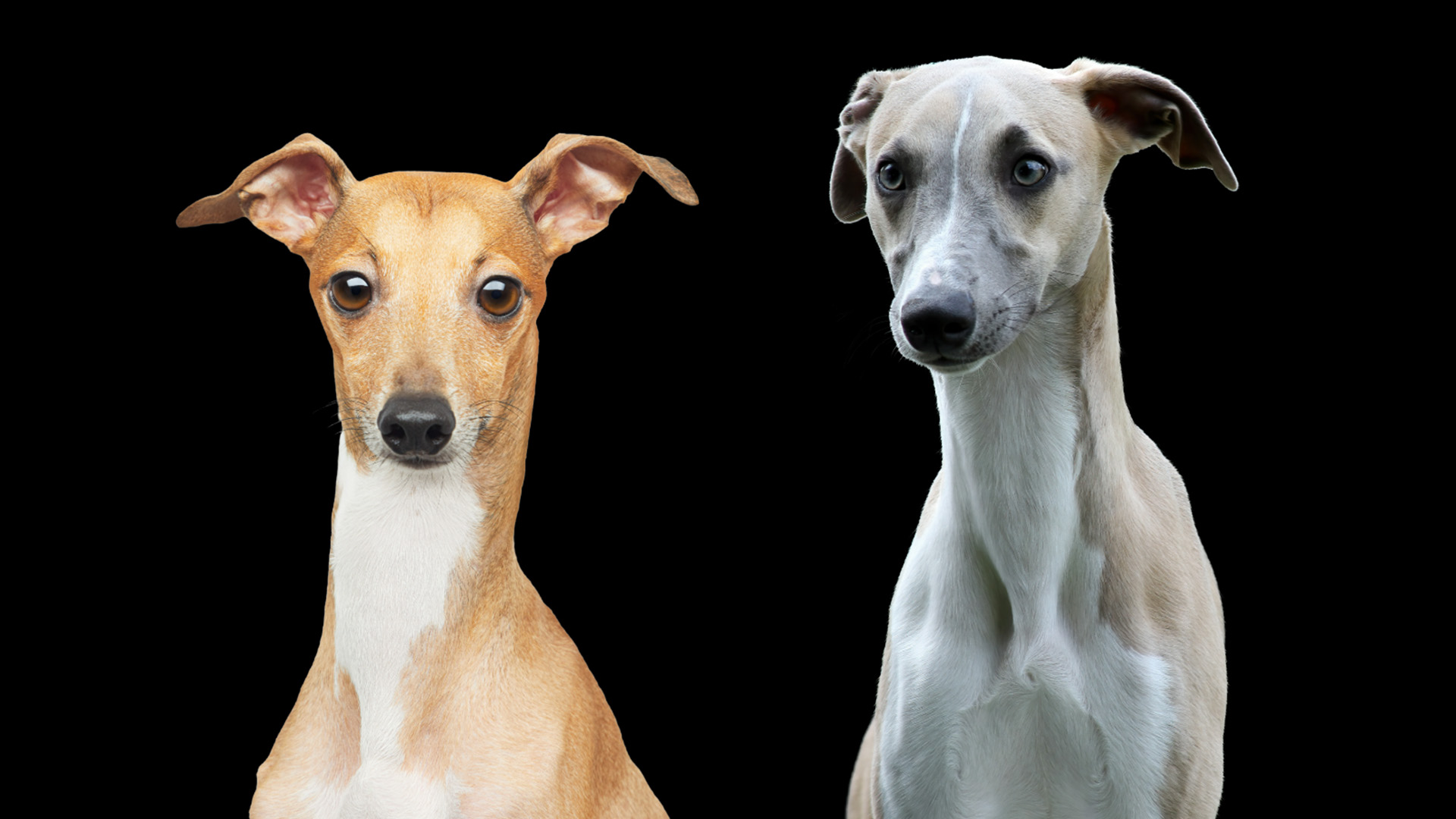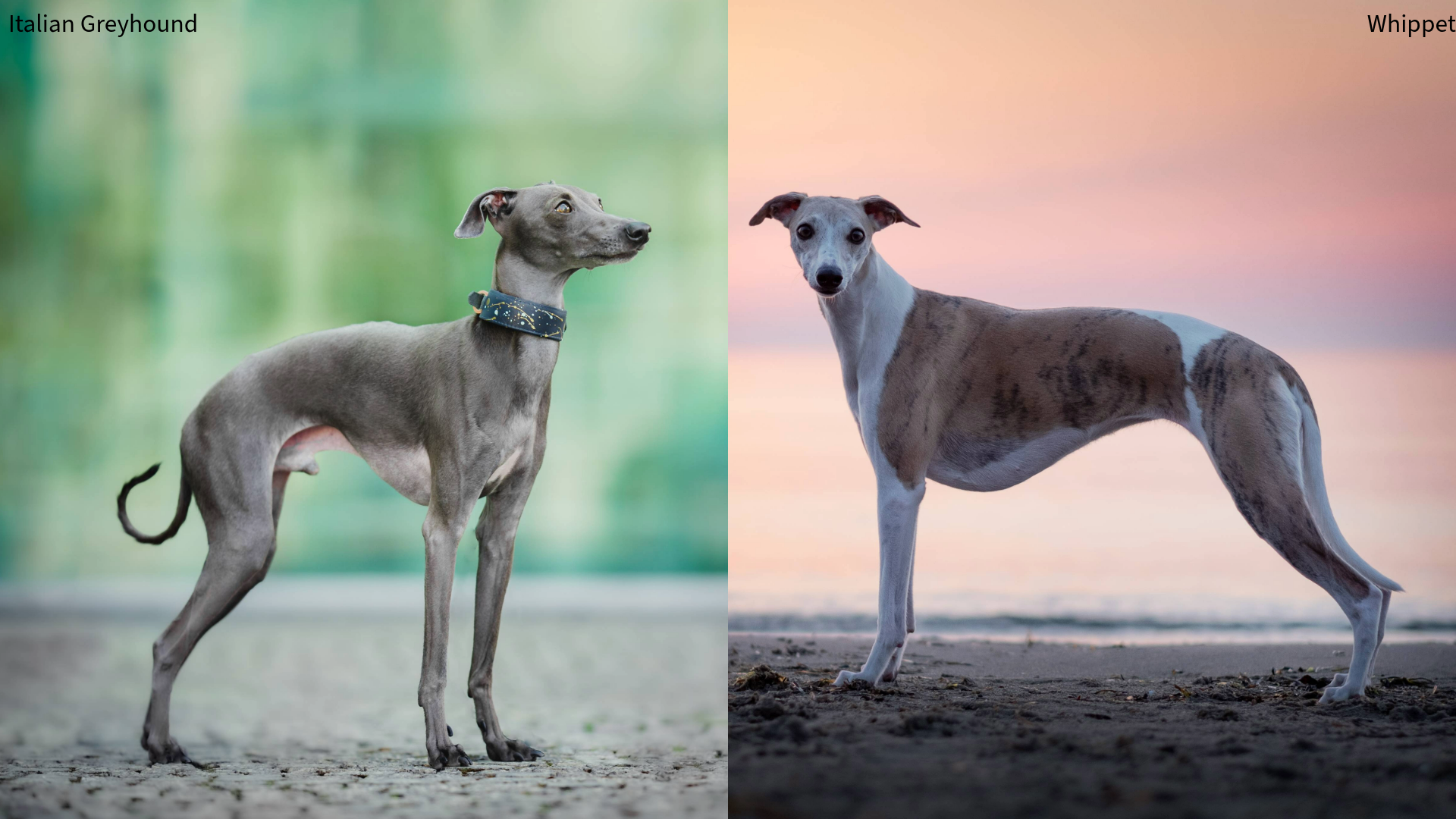Italian Greyhound vs whippet: Vet-verified breed comparison
Do you know the difference between an Italian Greyhound and a whippet? An expert explains how these sweet, docile breeds compare

What's the difference between an Italian Greyhound and a whippet? With their long, elegant legs and large, soulful eyes, these beautiful breeds look much alike and are often mistaken for one another.
Both of these dogs have a sweet and gentle nature and are very loving and affectionate toward their owners. While the Italian Greyhound tends to be sensitive and needy, whippets are more independent but still extremely loyal and sociable.
When it comes to running, these sighthounds are lightning fast and have lively personalities that make them great for people with busy, active lifestyles. However, it might come as a surprise that these dogs are also big fans of naps and don't need as much exercise as you might think.
While it's true that these breeds share a lot in common, there are a few key differences that set them apart, like their size, coat, and exercise needs, which we've explained below with the help of expert vet Dr Hannah Godfrey.
Appearance: Italian Greyhound vs whippet
Italian Greyhounds are the smaller breed of the two, measuring 13–15 inches in height and weighing 7–14 pounds. In comparison, Whippets stand 18–22 inches tall and weigh between 25–40 pounds.
These hounds come in a variety of colors, including black, blue, fawn, white, red, brindle, and parti-color, but whippets are more likely to have patterns or markings.
Both breeds have short, smooth coats, but Italian Greyhounds usually have a finer and silkier coat. In terms of physique, the whippet has long, strong legs and a more muscular build, while the Italian Greyhound is more delicate and slender.
Get the best advice, tips and top tech for your beloved Pets

Intelligence and trainability: Italian Greyhound vs whippet
If you're looking for a dog breed that's easy to train, the Italian Greyhound and whippet might not be for you. While training them isn't impossible – or particularly challenging – they're fairly average in terms of intelligence.
Dr Godfrey says: "That’s not to say they’re impossible to train, though. In my experience, both dogs can be quite attached and reliant on their owners, meaning they can be eager to please. This trait is always helpful when it comes to training, as they’re motivated to make you happy. If I had to choose which is more trainable out of the two breeds, I’d say that whippets have the edge."
Exercise needs: Italian Greyhound vs whippet
With their long legs and lean physique, you might expect these breeds to need a lot of exercise, but that's not completely true. While these dogs do need plenty of physical stimulation and fresh air, they love curling up on the couch to relax.
Dr Godfrey says: "Compared to Italian Greyhounds, whippets probably do require a little more exercise, just because they’re bigger dogs. However, despite their appearances, whippets are often very happy to have some chill time and might not be as keen to run as you’d expect – they quite enjoy being couch potatoes."

Grooming: Italian Greyhound vs whippet
Since these breeds have short, sleek fur that doesn’t shed much, they’re pretty low-maintenance when it comes to grooming and don’t need to be brushed as often as others.
However, it’s worth bearing in mind that they’re prone to overgrown nails, so you’ll need to stay on top of clipping them or have a vet help you. It will be worth investing in the best dog nail clippers to make the job easier.
Dr Godfrey says: "Having had to clip a lot of nails belonging to sighthounds over the years, I’d strongly advise getting them used to having their feet touched and nails trimmed from a young age to make it easier!"
Health considerations: Italian Greyhound vs whippet
According to Dr Godfrey, these breeds are also both prone to eye conditions such as Progressive Retinal Atrophy, which causes blindness in dogs. They may also develop autoimmune diseases and luxating patella, an orthopedic condition where the kneecap easily slips out of its groove.
She adds: "Italian Greyhounds may be more likely to get Legg-Calve-Perthes disease [a disease affecting the hip joint], while whippets may be more prone to mitral valve disease, a condition causing heart failure in some smaller breeds."

Owner suitability: Italian Greyhound vs whippet
There are many reasons to love these breeds, but before you commit to bringing one home, it’s important to make sure they’re the right fit for your home and lifestyle.
If you live in a household where people are around most of the time – or the dog can accompany them on outings – these dogs are likely to thrive. Both the Italian Greyhound and the whippet love company and enjoy being close to their owners.
Dr Godfrey adds: "The Italian Greyhound, in particular, is a clingy Velcro breed, so if you’re looking for something slightly more independent, a whippet might be a better choice. Both are reasonably easy to train and good with new people and other dogs. However, like any dog, these breeds require supervision with young children."
The Complete Guide to Italian Greyhounds | Amazon
After reading this book, you'll understand everything there is to know about training, feeding, socializing, grooming, and exercising an Italian Greyhound.
Whippet Complete Owners Manual | Amazon
From care advice to training tips, this book will teach you how to be the best possible owner of a whippet.
Want to learn about other sighthounds? Read our breed profiles for the Irish Wolfhound and Rhodesian Ridgeback. For whippet content, check out our comparison, greyhound vs. whippet. Or, read about these other dog breed lookalikes

Hannah graduated from the Royal Veterinary College in 2011 and began work straight away at a busy mixed practice. Initially, she treated all species, but focused on small animals from 2014. She has a passion for soft tissue surgery, ultrasound, and canine and feline dentistry, having completed additional training in these areas.
Edited by Georgia Guerin and Alexis De Leaver.
This page was last updated in June 2025 by Megan Milstead.

Megan is a Staff Writer at PetsRadar, covering features, reviews, deals, and buying guides. She has a wealth of experience caring for animals, having grown up with dogs, cats, horses, guinea pigs, and more throughout her life. She studied BA Journalism at the University of Westminster, where she specialized in lifestyle journalism and was editor of Smoke Radio’s lifestyle website. Megan works alongside qualified vets and accredited trainers to ensure you get the best advice possible. She is passionate about finding accurate and helpful answers to your pet-related questions.


